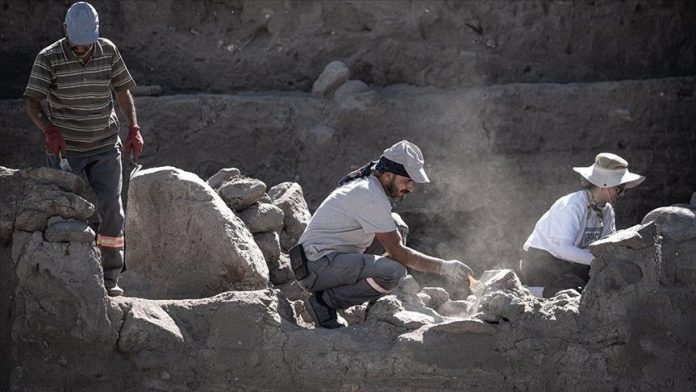Traces of a settlement dating back about 6,000 years have been found during excavations at Degirmenler Mound in Türkiye’s eastern Erzurum, reports Anadolu Agency. Starting on July 1, the two-month excavation in the area has uncovered settlement layers, human and animal bones, and ceramics, which are being analyzed.
The site has been determined to have been inhabited as far back as 6,000 years ago, and further deepening of the excavation is expected to reveal even older layers. As a result of the excavations, the area is planned to be transformed into an archaeological park.
Mehmet Isikli, a professor at Ataturk University in Erzurum and the scientific adviser of the project, told Anadolu that a different period began in Eastern Anatolia after the Kura–Araxes culture.
Isikli said that the first state and writing tradition in Eastern Anatolia came with Urartu, adding: “This was about 3,000 years ago, but we are still trying to understand the 2,000-year period in between, who lived during that time, and how they lived.
“We archaeologists refer to that period as the Late Bronze Age and Early Iron Age, which spans over a thousand years. The rescue excavation at Degirmenler Mound is actually providing very valuable data about this period,” he said.
He further noted that around 4,000 years ago, they encountered a strong societal structure in the region that lived on animal husbandry and agriculture.
Associate Professor Gulsah Altunkaynak, who is the archaeologist at Erzurum Museum and also the excavation coordinator, said that the archaeology of the region has been developing mostly on rescue excavations for many years.
Highlighting the valuable results from their findings, Altunkaynak said: “Here, we are actually trying to reach the earliest settlement as quickly as possible. Our goal is to leave a step in each layer using the step trench method and to uncover the periods and building phases.”
“In our work so far, we first uncovered a medieval cemetery at a fill depth of approximately 1.5 meters, after which the Iron Age layer began. We started to uncover this layer along with various construction phases and encountered much more architectural fill than we expected,” she said.
Altunkaynak added: “Degirmenler Mound will likely provide a more extensive Kura–Araxes fill, allowing us to obtain findings we have not seen before. At least, that is our hope.
“Beyond Kura – Araxes, we may identify an even earlier settlement than Alaybeyi, and in this way, we aim to discover the earliest settlement in the region. Until now, it was generally believed that there were no early settlements in this mountainous area during the earliest periods.
“In these studies, we are actually trying to determine that, contrary to what is known, there were settlements in this region in very early periods. Our current findings go back 5,500 to 6,000 years; we can see the Kura–Araxes culture, but we need to dig deeper to find earlier periods.”




